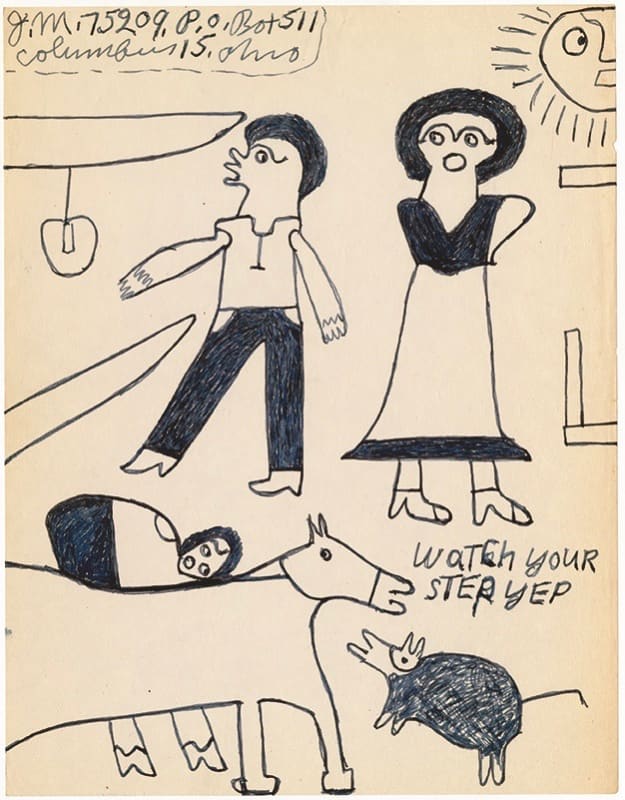Joe Massey American, 1895-?
In his review of Joe Massey's original "thug life" drawings shown at Ricco/Maresca Gallery in NYC in 2019, Mark Bloch describes their "lovable but menacing charm-a deep wrongness that somehow looks right. They survive because in the 1940s, Joseph Cyrus Massey, an incarcerated African American man, sent mail embellished with sketches and stamped CENSORED, to the ultimate aesthete, Charles Henri Ford, on East 53rd Street in Manhattan for the trailblazing Surrealist magazine, View. The scenarios are normal enough. . . .
"But closer looks reveal an unapologetically strange world: Characters float in peculiar landscapes: mega-human forms on display, fused into conjoined twins or multi-armed anthropomorphic snowflake-beings. Mouths and eyes are simple circles, the former agape, the latter with dots added, somehow expressing instant emotion from alarm to delight. In profile, human noses and mouths become beaks, or mountain peaks, oddly paralleling animal faces. . . . Suns preside over the action from the upper right, sporting mandala eyes and smiles, smirks or sneers, revealing their opinions of the scenarios below. Some of Massey's four-legged creatures and humanoid colleagues predict Keith Haring gingerbread-man silhouettes, but feel more enigmatic, intriguing and disturbing."
"I have made a mistake in my life, and I am trying to make the best of it," Massey wrote, "to overcome my past mistakes. And to rehabilitate myself. I am waiting for a better day."
Massey was born in 1895. When trying to kill his wife, he accidentally killed the wrong woman in Little Rock. He was sentenced to ten years but served only one by escaping and living as a fugitive for two decades. Next, he shot and killed his second wife, escaping the electric chair but sentenced to life in prison in Columbus, where these drawings originated. He was paroled in 1959 and released in 1965. In 1961, Greenwich Book Publishers published Singing Stars, a book of his poems.
Ford published Massey's artwork, sending back issues of View, checks, and art paper, encouraging further production, and creating a dilemma for the viewer: Can we separate the art from the act? Is it permissible to laud the artwork of a murderer?
"Massey signed every work in the upper left corner with his initials, prisoner number (inmate no. 75209), and a Columbus P.O. Box, acutely aware of who and where he was. After his release, no trace of him remained. The visual evidence from his previous life is all that's left."
Mark Bloch, "Shut Up: Joe Massey's Messages from Prison: Is it OK to revel in a murderer's art?" The Brooklyn Rail, Oct 2019.



